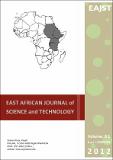| dc.contributor.author | Maina John Nyongesah, Wang Quan, Otieno Dennis, Oula Dorah, Mupenzi Jean de la Paix, Onyango John Collins | |
| dc.date.accessioned | 2020-12-04T06:57:37Z | |
| dc.date.available | 2020-12-04T06:57:37Z | |
| dc.date.issued | 2012 | |
| dc.identifier.uri | https://repository.maseno.ac.ke/handle/123456789/3261 | |
| dc.description.abstract | Savannas are key ecosystems that provide vital services such as fodder for wild and
domestic animals, recreation, biodiversity habitats, CO2 sequestration and timber. Their
characteristics and distribution make them relatively susceptible to disturbances such as land-use
and climate change. This study was carried out to monitor seasonal changes in soil moisture, soil
and plant nutrients, and grass primary production as well as establish the impacts of grazers and
Acacia trees on ecosystem processes in a humid tropical savanna. Soil moisture, soil and plant
N/C content and grass biomass were monitored in grazed, non-grazed, under canopy and open
locations. Soil moisture was monitored through core method, N and C concentrations (%) were
determined by means of elementary analysis while biomass was assessed through harvest
method. The results indicated an increase in above ground biomass with progression of wet
season with peaks of 1757.6346 and 1906.75115 g/(m2
•a) recorded in grazed and non-grazed
plots respectively. Understorey sites recorded significantly (p<0.001) higher peak aboveground
biomass compared to open sites. Significantly higher soil and shoot N content, 0.350.1 and
0.930.28 %, respectively were observed in the understorey sites, while %C content declined
with progress of wet season. In this humid ecosystem, grazers were responsible for keeping
grasses low during the dry season; however, they had minimum influence on primary production
during the growing season. Acacia species strongly influenced organic matter accumulation, soil
moisture and biomass production under their canopies. The observed trends created a unique
production mosaic of ecosystem function and productivity in the humid savanna. This ecosystem
can therefore be a significant source and sink of both N and C with processes that control their
emissions being complex and influenced by a variety of interrelated factors such as quality and
rates of organic matter turn over. Therefore, processes in humid savannas are not a simple
function of rainfall patterns or herbivory, but regulated by interactive effects of grazing and
nutrients with trees acting as modifiers. | en_US |
| dc.publisher | East African Journal of Science and Technology, | en_US |
| dc.subject | Grazing, Understorey, Primary production, Nutrients, Ruma national park | en_US |
| dc.title | Interactive effects of livestock and trees on nutrients and herbaceous layer production in a humid Kenyan savanna | en_US |
| dc.type | Article | en_US |

